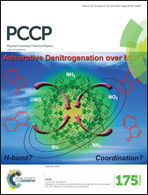Fractional electron number, temperature, and perturbations in chemical reactions
Abstract
We provide a perspective on the role of non-integer electron number in the density functional theory approach to chemical reactivity (conceptual DFT), emphasizing that it is important to not only treat reagents as open systems, but also as non-isolated systems, in contact with their surroundings. The special case of well-separated reagents is treated in some detail, as is the case where reagents interact strongly. The resulting expressions for the chemical potential of an acid, μacid = −(αI + A)/(1 + α), and a base, μbase = −(I + αA)/(1 + α), elucidate and generalize the assumptions inherent in the chemical potential models of Mulliken (α = 1) and Gazquez, Cedillo, and Vela (α = 3). In the strongly-interacting limit, it is appropriate to model the effects of the environment as a state-specific effective temperature, thereby providing a rigorous justification for the phenomenological effective-temperature model one of the authors previously proposed. The framework for the strongly interacting limit subsumes our model for weakly-interacting subsystems at nonzero temperature, the case of open but otherwise noninteracting subsystems, and the zero-temperature limit.


 Please wait while we load your content...
Please wait while we load your content...